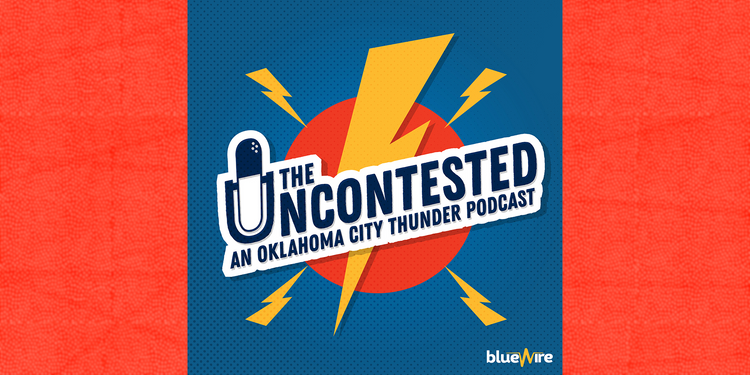Trading up is hard to do


Now that the Thunder is locked into the 14th overall selection in the draft, it’s time to work up some deals and trade up. I mean, trade down for what, am I right?
(I’m so sorry. The back button is in your upper left-hand corner.)
Before fans could get RealGM’s Trade Checker loaded, Sam Presti slammed on the brakes for us like a driver’s education teacher. “I think history shows it’s not an easy proposition to move up into the lottery.”
It’s not impossible, but the conditions have to be perfect (which, frankly, is no different than any other NBA trade). There have been a few deals involving top-10 picks in the past few drafts. If history is indeed any indication, the Thunder may not have the goods to move up, or they may not be willing to part with what it would take to do so.
In 2014, the Magic traded up from 12 to 10, but had to surrender a 2017 first round pick to do so. That’s the sort of trade the Thunder aren’t in great position to make. Because the Thunder owe protected picks to Philadelphia in 2016 and Utah in 2018, the earliest first round pick they can offer is a conditional one in 2020, unless they pick up another future first rounder along the way. The pesky “Stepien Rule” prohibits teams from going consecutive future years without a first round draft pick.
Consider the 2013 draft, which was considered “bad” and “awful” by most accounts.* The Sixers traded All-Star point guard Jrue Holiday to get the sixth pick and a future first rounder. The Sixers were ready to tear down and the Hornetelicans wanted to accelerate their rebuild, and thus a deal was born. Or to further quote Presti, “It always comes down when making a transactions with another team is finding how to partner so that you have aligned interests with them.”
* I still remember Bill Simmons declaring that the Thunder got “the 12th pick in an 11-player draft” in 2013. Neither Giannis Antetokounmpo nor Rudy Gobert could be reached for comment.
Another side note: this was the draft where the Thunder reportedly tried to trade with Cleveland and score the first overall pick, possibly in order to select Victor Oladipo.
The Jazz had the 14th pick in that same draft and moved up to 9th, but they pulled that off because they could offer the 21st pick as well. It seemed like a bit much to surrender at the time, and the trade hasn’t looked much better in the two years since. Giving up both Shabazz Muhammed and Gorgei Dieng for Trey Burks doesn’t look particularly good in hindsight.
Despite the pessimism, you never know what another team with a questionable level of competence will agree to. In 2011 the Charlotte Bobcats traded the 19th pick (Tobias Harris) along with Stephen Jackson (owed $19 million) and Shaun Livingston (owed $4.5 million) and wound up with the 7th overall pick (Bismack Biyombo) and the remaining $21 million of Corey Maggette’s deal. It’d be a heckuva accomplishment except for the fact that Harris turned out to be the best player in the entire trade.
In the same deal, the Bucks traded the 10th pick (Jimmer Fredette) and $45 million in future salary in exchange for Harris and nearly $40 million in future commitments. Again, Harris turned out to be pretty good but they didn’t get whatever it was they were expecting from Jackson, whom they acquired from Charlotte. To make matters worse, Harris would later be traded to Orlando in order to rent J.J. Redick for a couple of months.
As for the Kings, they turned the 7th pick into the 10th pick (because ownership was hot for Fredette) and turned Beno Udrih’s $14.3 million in future money into John Salmons’ $24 million in future money. To this day I still think someone in the Kings front office had a broken formula in their Excel spreadsheets when they were crafting this deal. You don’t essentially pay another team $10 million in order to trade down. Not for John Salmons, anyway. You just don’t.
But I digress. The Thunder could potentially move up, but it’d be difficult to do without sacrificing a key rotation player. I can’t imagine that the old tried and true package of Jeremy Lamb and Perry Jones would have the value of a future first round pick, so including them in a deal probably isn’t very persuasive. Trading them in exchange for a pick in the low teens/early twenties in this draft doesn’t seem terribly realistic either, if you’re looking to recreate something like that aforementioned Minnesota/Utah deal.
Something else could come out of left field. Perhaps the Thunder could move up by buying debt, which they’ve done in the past. Although that particular deal, absorbing Morris Petersen’s $6.6 million commitment in order to move up and draft Cole Aldrich, was made largely possible because the then-Hornets were in the luxury tax and going broke. That sort of financial reality isn’t present in 2015.
But hey, maybe someone else’s @SUM formula is busted.

